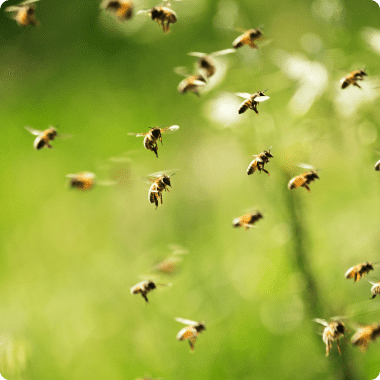Installation of biomonitoring sensors
BeeGuard's professional sensors are easily adapted to existing hives. There is very little need for the beekeeper to intervene on the sensors.
This service enables farmers, businesses or regions to generate environmental impact indicators for pollinators.

| Measurements and indicators per hive | Biomonitoring Basic | Biomonitoring Start | Biomonitoring BeeLive | Biomonitoring Premium |
|---|---|---|---|---|
| Commitment contract | 3 years | 3 years | 3 years | 3 years |
| Weight variation | ||||
| Temperature and internal hygrometry | ||||
| Weather conditions | ||||
| BeeLive the bee counter | ||||
| Beekeeper access for evaluation, visits, etc... | ||||
| Access to dashboards and data | ||||
| Availability of food resources indicator | ||||
| Activity measurement | ||||
| Daily mortality indicator | ||||
| Installation option | On quotation | On quotation | On quotation | On quotation |
| Annual analytical report option | 700€ EXCLUDING VAT | 700€ EXCLUDING VAT | ||
| BeeLive solar feed option | - | - | 350€ EXCLUDING VAT | 350€ EXCLUDING VAT |
|
Feedback participation option |
On quotation | On quotation | On quotation | On quotation |
| TOTAL | 550€ HT / year / hive | 1150€ / year / hive | 1500€ HT / year / hive | 2100€ / year / hive |

Environmental biomonitoring services using bees enable existing hives to be fitted with sensors to produce data automatically and continuously characterising the activity and health of the bees. This service enables farmers, businesses and local authorities to generate indicators of the impact of and on the environment as seen through the eyes of pollinators.


In order to characterise the environment, the principle of biomonitoring is to automatically and continuously analyse the activity and health of bees. Thanks to its 3km foraging radius, the bee will be able to integrate the presence or scarcity of food and water, as well as any collisions with pollutants or toxic products. The BeeGuard solution enables the hive to reveal what the bees are experiencing in our environment, providing robust and reliable indicators of environmental impact. But you need bees, and that means at least one hive. You don't have a beehive on your land today? That's not a problem. Beekeepers can easily transport hives. You have several options: find a beekeeper nearby who will install and manage your hive(s), BeeGuard can put you in touch with its beekeeper partners, or call on a company specialising in hive installation with associated services such as animation, training, etc... Contact us and we'll put you in touch with our partners.
First of all, you need to know that bees die every day because bees are born every day. The problem is when the colony collapses, i.e. when the whole hive dies. There are several possible causes: lack of nutrition, problems with the queen (who stops laying eggs, for example), poisoning, disease, etc. By monitoring the hive with BeeGuard sensors, we can analyse the characteristics of this collapse, if it occurs, and thus determine the time and cause of the bee depopulation. If it is a health problem, the environment is not directly to blame. On the other hand, if one day 60% of the foragers don't return, it's obvious that the bees have suffered an external defect that can be dated. If the colony dies after 6 months of food shortage, we can consider that food stress has contributed to this situation. Based on these factual observations, it is much easier to implement actions to compensate, reduce or avoid the problem. For example, planting plant cover to flower during the period of deficit in order to compensate for the structural deficit in the environment. Contact us to talk about it.
Greenwashing is generally the practice of over-communicating, usually with a certain marketing flair, about one's commitment to the environment but without actually doing anything about it. The best way to differentiate yourself from greenwashing is to take action. The bee biomonitoring approach is based on science: the bee is not a pretty picture but a living insect that we use as a bioindicator. The result is concrete, comparable, localised measurements that can be positioned in relation to the actions taken. Measures are the best way of distinguishing ourselves from greenwashing. And that doesn't mean you can't take a pretty picture. Contact us for more information.


